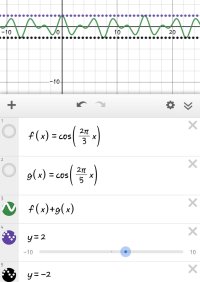Agent Smith
Junior Member
- Joined
- Oct 18, 2023
- Messages
- 211

I hope the diagram is self-explanatory. I didn't we could express multiples of a number with a trig function. I've used the cosine function here. Each multiple of a number [imath]n[/imath], I've used 3 and 5, appears as the [imath]x[/imath] value for which [imath]y = \cos x = 1[/imath] (the cosine function's periods have been recalibrated to 3 and 5).
As you can see we have peaks/troughs, categorizable into local & global. I know that the global zeniths are common multiples, they resonate as it were. So, the maxima are x = {15, 45, 60, ...}.
An interference pattern for numerical waves.
Using simple functions:
f(x) = 3x
g(x) = 5x
The plot above corresponds to h(x) = [imath]\frac {f(x)g(x)}{x} = f(\sqrt x)g(\sqrt x)[/imath]
What are the other minima/maxima?
Anything else worth noting?
